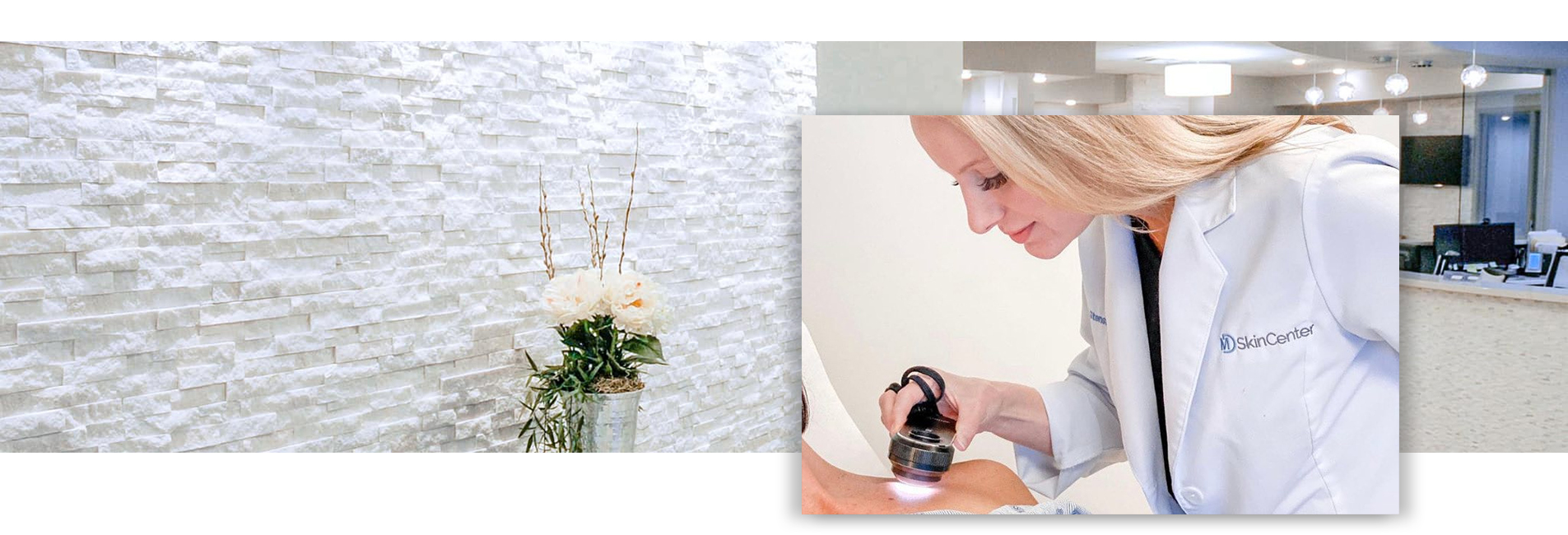Medical Dermatology
Dermatologists diagnose and treat over 3,000 different diseases. MD SkinCenter is dedicated to providing patients with the best in individualized care by staying current with the latest advances in dermatology and utilizing state-of-the-art technology and specialized techniques. We are committed to helping our patients achieve and maintain healthy skin. Below, you can read about some of the most common skin conditions and how we can help you manage them.
The most common skin issue that doctors encounter is acne. It is made up of pimples that show up on the chest, back, and face. About 5% of adults get acne, whereas about 80% of adolescents do. Sebaceous glands, located beneath the skin and responsible for producing sebum, are oil glands in healthy skin. Our MD SkinCenter providers customize treatment to each patient, ensuring best results. Additionally, our cosmetic service providers offer many helpful treatments for acne, resultant blemishes, and scarring.
Hair loss has many causes. Your dermatologist will ask questions such as the timing of your hair loss, family history, associated symptoms such as itching or scaling, and past treatment. Once a diagnosis or cause is determined, a diagnosis – specific treatment plan can be initiated.
A common scalp condition, dandruff can cause itching and flaking on the scalp. It is more common in both children and elderly, but can occur at any age. Anti-dandruff shampoos are available over-the-counter, but for more severe cases your dermatologist will institute a treatment plan to control your symptoms.
Hives, also known as urticaria, are red and sometimes itchy bumps on the skin. They are transient and move from place to place on the skin. Causes may include infections and medications, but often the specific cause cannot be determined. Treatments include antihistamines and prescription medications.
Excessive sweating that may not be related to heat or exercise is referred to as hyperhidrosis. It can cause significant social anxiety and embarrassment. Treatment can include over-the-counter antiperspirants, but sometimes prescriptions medication or even botulinum toxin injection may be needed to control symptoms.
Melsams is a skin condition that causes patches of hyperpigmentation, usually on the face. It is caused by sun exposure and more common in females due to worsening with hormones. Individualized treatment and a commitment to sun avoidance is essential for improvement.
Moles are growths that can form anywhere on the skin and are typically round or oval in shape. They can be solitary or several, rough or smooth, flat or elevated. They develop when the melanocytes—the cells that produce color in the skin—grow in groups rather than uniformly throughout the skin. Moles often measure less than a quarter of an inch. Although some moles may occur later in life, the majority of moles appear before the age of 20.
Nail abnormalities can be caused by a wide variety of causes and it will often require a physician to determine the cause.
Psoriasis is a skin ailment characterized by red patches of skin covered in white, flaky scales. It usually appears on the elbows, knees, and trunk, but it can arise anywhere on the body. The first episode occurs between the ages of 15 and 35. It is a chronic condition that will have flare-ups and remissions for the rest of the patient's life. In the United States, 7.5 million people suffer with psoriasis. Psoriasis has been identified in approximately 20,000 youngsters under the age of ten.
The term “rash” refers to a wide range of skin disorders. A rash is a skin alteration that typically appears as a red patches, bumps, or even blisters on the skin. A trained dermatologist can examine and determine a cause for the rash, although sometimes lab tests or biopsies may be necessary. Treatment will depend on the cause and often includes prescription medications.
Rosacea is a chronic skin disorder characterized by facial redness, acne-like pimples, visible tiny blood vessels, swelling, and/or watery, irritated eyes. This type of facial inflammation can affect the cheeks, nose, chin, forehead, or eyelids. Rosacea affects almost 14 million Americans. It is not contagious, however there is evidence that it can be inherited.
Skin cancer is one of the most common cancers in the human body, affecting over 1 million Americans each year. Approximately 1 in 5 Americans will experience skin cancer at least once in their lifetime. Skin cancer is usually curable if it’s caught early. Regular screening by a trained dermatologist can help to detect skin cancer.
Vitiligo causes your skin to lose color or pigmentation. Smooth white or light areas called macules or patches appear on your skin. It generally starts on your hands, forearms, feet and face. Globally, about 1% of the population has vitiligo. Treatment isn’t necessary, but it’s available if you don’t like the changes to your skin tone.
Warts are small, harmless growths that appear most frequently on the hands and feet. Sometimes they look flat and smooth, other times they have a dome-shaped or cauliflower-like appearance. Warts can be surrounded by skin that is either lighter or darker. Warts are caused by different forms of Human Papilloma Virus (HPV). They occur in people of all ages and can spread from person-to-person and from one part of the body to another. Warts are benign (noncancerous) and generally painless.
Wrinkles are a natural part of the aging process. They occur most frequently in areas exposed to the sun, such as the face, neck, back of the hands and forearms. Over time, skin gets thinner, drier and less elastic. Ultimately, this causes wrinkles - either fine lines or deep furrows. In addition to sun exposure, premature aging of the skin is associated with smoking, heredity and skin type (higher incidence among people with fair hair, blue-eyes and light skin).
We also provide skin procedures including:
- Cyst Removal
- Mole Removal
- Skin Cancer Treatment
- Skin Tag Removal


